ISS | Credit: NASA
ISS | Credit: NASA
Time-lapse imagery captured June 25, 2017 by Expedition 52.
More Posts from Xyhor-astronomy and Others

Curiosity drill site reveals that under its red surface, Mars is grey-blue
via reddit










The Largest Black Hole Merger Of All-Time Is Coming, And Soon
“Over in Andromeda, the nearest large galaxy to the Milky Way, a number of unusual systems have been found. One of them, J0045+41, was originally thought to be two stars orbiting one another with a period of just 80 days. When additional observations were taken in the X-ray, they revealed a surprise: J0045+41 weren’t stars at all.”
When you look at any narrow region of the sky, you don’t simply see what’s in front of you. Rather, you see everything along your line-of-sight, as far as your observing power can take you. In the case of the Panchromatic Hubble Andromeda Treasury, where hundreds of millions of stars were captured in impressive fashion, background objects thousands of times as distant can also be seen. One of them, J0045+41, was originally thought to be a binary star system that was quite tight: with just an 80 day orbital period. Follow-up observations in the X-ray, however, revealed that it wasn’t a binary star system after all, but an ultra-distant supermassive black hole pair, destined to merge in as little as 350 years. If we build the right observatory in space, we’ll be able to observe the entire inspiral-and-merger process for as long as we like!
Come get the full story, and some incredible pictures and visuals, on today’s Mostly Mute Monday!

When (Neutron) Stars Collide via NASA http://ift.tt/2hK4fP8

Neptune Clouds
This Voyager 2 high resolution color image, taken 2 hours before closest approach, provides obvious evidence of vertical relief in Neptune’s bright cloud streaks.
Credit: NASA / Voyager 2
![Andromeda [x]](https://64.media.tumblr.com/aa70ce40e59ba0f9da6e334afac731fe/tumblr_ox11noOQXn1tuy5mao1_500.jpg)
Andromeda [x]
js

Massive Stars in Open Cluster Pismis 24
How massive can a normal star be? Estimates made from distance, brightness and standard solar models had given one star in the open cluster Pismis 24 over 200 times the mass of our Sun, making it a record holder. This star is the brightest object located just above the gas front in the above image. Close inspection of images taken recently with the Hubble Space Telescope, however, have shown that Pismis 24-1 derives its brilliant luminosity not from a single star but from three at least. Component stars would still remain near 100 solar masses, making them among the more massive stars currently on record. Toward the bottom of the image, stars are still forming in the associated emission nebula NGC 6357, including several that appear to be breaking out and illuminating a spectacular cocoon.
Credit: NASA, ESA and J. M. Apellániz (IAA, Spain)

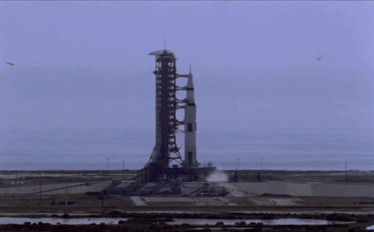
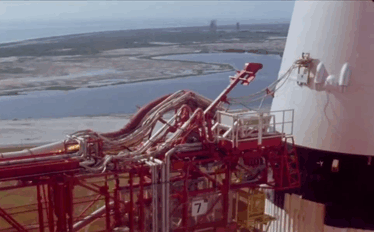
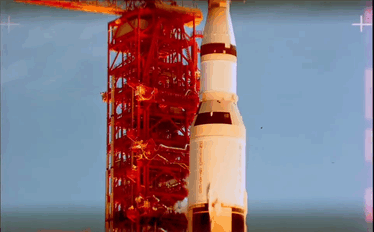
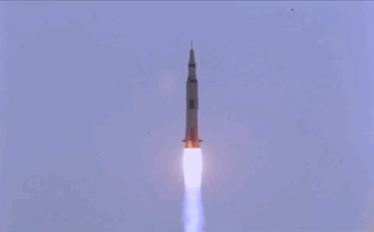
Apollo 11 Launch
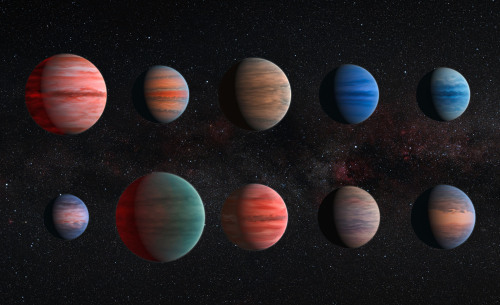
This image shows an artist’s impression of the 10 Hot Jupiter Exoplanets studied using the Hubble and Spitzer Space Telescopes. From the upper left to the lower right corner, these planets are WASP-12b, WASP-6b, WASP-31b, WASP-39b, HD 189733b, HAT-P-12b, WASP-17b, WASP-19b, HAT-P-1b And HD 209458b.
Credit: ESA / Hubble & NASA
Why Webb Needs to Chill
Our massive James Webb Space Telescope is currently being tested to make sure it can work perfectly at incredibly cold temperatures when it’s in deep space.
How cold is it getting and why? Here’s the whole scoop…
Webb is a giant infrared space telescope that we are currently building. It was designed to see things that other telescopes, even the amazing Hubble Space Telescope, can’t see.

Webb’s giant 6.5-meter diameter primary mirror is part of what gives it superior vision, and it’s coated in gold to optimize it for seeing infrared light.

Why do we want to see infrared light?
Lots of stuff in space emits infrared light, so being able to observe it gives us another tool for understanding the universe. For example, sometimes dust obscures the light from objects we want to study – but if we can see the heat they are emitting, we can still “see” the objects to study them.
It’s like if you were to stick your arm inside a garbage bag. You might not be able to see your arm with your eyes – but if you had an infrared camera, it could see the heat of your arm right through the cooler plastic bag.

Credit: NASA/IPAC
With a powerful infrared space telescope, we can see stars and planets forming inside clouds of dust and gas.

We can also see the very first stars and galaxies that formed in the early universe. These objects are so far away that…well, we haven’t actually been able to see them yet. Also, their light has been shifted from visible light to infrared because the universe is expanding, and as the distances between the galaxies stretch, the light from them also stretches towards redder wavelengths.
We call this phenomena “redshift.” This means that for us, these objects can be quite dim at visible wavelengths, but bright at infrared ones. With a powerful enough infrared telescope, we can see these never-before-seen objects.

We can also study the atmospheres of planets orbiting other stars. Many of the elements and molecules we want to study in planetary atmospheres have characteristic signatures in the infrared.

Because infrared light comes from objects that are warm, in order to detect the super faint heat signals of things that are really, really far away, the telescope itself has to be very cold. How cold does the telescope have to be? Webb’s operating temperature is under 50K (or -370F/-223 C). As a comparison, water freezes at 273K (or 32 F/0 C).
How do we keep the telescope that cold?
Because there is no atmosphere in space, as long as you can keep something out of the Sun, it will get very cold. So Webb, as a whole, doesn’t need freezers or coolers - instead it has a giant sunshield that keeps it in the shade. (We do have one instrument on Webb that does have a cryocooler because it needs to operate at 7K.)

Also, we have to be careful that no nearby bright things can shine into the telescope – Webb is so sensitive to faint infrared light, that bright light could essentially blind it. The sunshield is able to protect the telescope from the light and heat of the Earth and Moon, as well as the Sun.

Out at what we call the Second Lagrange point, where the telescope will orbit the Sun in line with the Earth, the sunshield is able to always block the light from bright objects like the Earth, Sun and Moon.

How do we make sure it all works in space?
By lots of testing on the ground before we launch it. Every piece of the telescope was designed to work at the cold temperatures it will operate at in space and was tested in simulated space conditions. The mirrors were tested at cryogenic temperatures after every phase of their manufacturing process.

The instruments went through multiple cryogenic tests at our Goddard Space Flight Center in Maryland.

Once the telescope (instruments and optics) was assembled, it even underwent a full end-to-end test in our Johnson Space Center’s giant cryogenic chamber, to ensure the whole system will work perfectly in space.

What’s next for Webb?
It will move to Northrop Grumman where it will be mated to the sunshield, as well as the spacecraft bus, which provides support functions like electrical power, attitude control, thermal control, communications, data handling and propulsion to the spacecraft.

Learn more about the James Webb Space Telescope HERE, or follow the mission on Facebook, Twitter and Instagram.
Make sure to follow us on Tumblr for your regular dose of space: http://nasa.tumblr.com.
The NASA Village
Today in the NASA Village… Making More with Less

Stacey Boland works at NASA’s Jet Propulsion Laboratory (JPL) on missions that use remote sensing instruments for Earth observation. From space, we can learn so much about our changing environment here on Earth.
Maximizing science research requires finding creative and cost effective ways to do it! Her team developed the ISS-RapidScat instrument using left over equipment NASA had in storage from a program launched in the 1990’s. ISS-RapidScat is an external payload mounted to the outside of the Columbus module, part of the International Space Station. ISS-RapidScat measures ocean wind speed and direction to help track tropical cyclones and hurricanes. Stacey’s team was able to get a functioning piece of hardware for about a tenth the cost of a traditional “small” Earth science mission.
Stacey said, “It wasn’t easy, but it was worth it! Working in the space program doesn’t require perfection - but it does require passion and hard work! We work as a team here at NASA and everyone’s role is important. We rely on each other to do our best, regardless of what part of the mission is “ours.” All the parts need to work together for it to be a success and that takes teamwork and good communication!”
Stacey’s story represents how being creative in the NASA Village can really make a difference!

Where did Stacey get her hunger for space? “When I was growing up, my dad and I would learn about each shuttle mission and then watch launches on TV together. It was fun learning about science and exploration together. Now, as a parent, I’m continuing on that tradition with my son”
“I was able to watch the SpaceX-4 launch in person with my mom, dad, husband, and son”, Stacy said. “It was absolutely incredible to share that experience with them. My son still talks about it and has been practicing drawing rockets ever since. He often asks when we can go back to Florida to see another one!”
Experiencing a rocket launch in person is amazing. Feeling the sound waves from the engines push against your body is quite a rush. And when it is hardware you helped create, on its way into space, it makes that experience even more special.
Next time on the NASA Village… A visit to the NASA Village inspires a lifelong career.
Do you want more stories? Find our NASA Villagers here!
-
 reem-alajrami liked this · 4 months ago
reem-alajrami liked this · 4 months ago -
 timallenphoto liked this · 7 years ago
timallenphoto liked this · 7 years ago -
 charlotteandcompany liked this · 7 years ago
charlotteandcompany liked this · 7 years ago -
 spacewakerone reblogged this · 7 years ago
spacewakerone reblogged this · 7 years ago -
 wurfel1-blog reblogged this · 7 years ago
wurfel1-blog reblogged this · 7 years ago -
 meinu2 liked this · 7 years ago
meinu2 liked this · 7 years ago -
 goodgollymissssmolly-blog reblogged this · 7 years ago
goodgollymissssmolly-blog reblogged this · 7 years ago -
 goodgollymissssmolly-blog liked this · 7 years ago
goodgollymissssmolly-blog liked this · 7 years ago -
 tamacoochy reblogged this · 7 years ago
tamacoochy reblogged this · 7 years ago -
 qtpocprince-ss liked this · 7 years ago
qtpocprince-ss liked this · 7 years ago -
 partyy-pat reblogged this · 7 years ago
partyy-pat reblogged this · 7 years ago -
 jonyborry34 liked this · 7 years ago
jonyborry34 liked this · 7 years ago -
 xyhor-astronomy reblogged this · 7 years ago
xyhor-astronomy reblogged this · 7 years ago -
 charlotteandcompany reblogged this · 7 years ago
charlotteandcompany reblogged this · 7 years ago -
 sithiegoodness reblogged this · 7 years ago
sithiegoodness reblogged this · 7 years ago -
 naturenestd-blog liked this · 7 years ago
naturenestd-blog liked this · 7 years ago -
 itsanserhere-blog reblogged this · 7 years ago
itsanserhere-blog reblogged this · 7 years ago -
 thefabtomato-blog liked this · 7 years ago
thefabtomato-blog liked this · 7 years ago -
 the-tired-cryptid liked this · 7 years ago
the-tired-cryptid liked this · 7 years ago -
 itsanserhere-blog liked this · 7 years ago
itsanserhere-blog liked this · 7 years ago -
 speaking-of-loyalty liked this · 7 years ago
speaking-of-loyalty liked this · 7 years ago -
 artistic-shell reblogged this · 7 years ago
artistic-shell reblogged this · 7 years ago -
 artistic-shell liked this · 7 years ago
artistic-shell liked this · 7 years ago -
 king-satan-nipple reblogged this · 7 years ago
king-satan-nipple reblogged this · 7 years ago -
 wheez-im-moderately-okay-blog liked this · 7 years ago
wheez-im-moderately-okay-blog liked this · 7 years ago -
 quantum-mecha reblogged this · 7 years ago
quantum-mecha reblogged this · 7 years ago -
 quantum-mecha liked this · 7 years ago
quantum-mecha liked this · 7 years ago
For more content, Click Here and experience this XYHor in its entirety!Space...the Final Frontier. Let's boldly go where few have gone before with XYHor: Space: Astronomy & Spacefaring: the collection of the latest finds and science behind exploring our solar system, how we'll get there and what we need to be prepared for!
128 posts